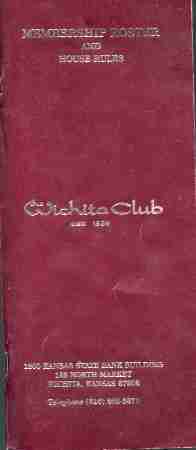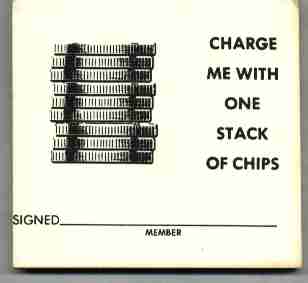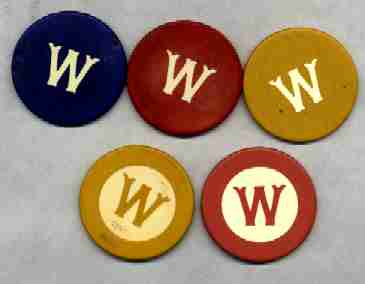It was the year 1872… Wichita was the liveliest, most uproarious town between
the two oceans. Large signboards posted at four conspicuous entrances to the
town read “Anything Goes in Wichita” and everything did go in Wichita. There
was not a gambling device known to the world that was not openly being operated,
every other building a saloon, where scantily clad women presented their stage
shows.
The streets clanged with the noisy spurs of Texas cowboys, while the crowds
along the board sidewalks jostled buckskin clad frontiersmen and Indians wrapped
in highly colored blankets.
It was here in Wichita that the huge herds of Texas cattle were shipped east,
and as much as two million dollars easily changed hands in a year.
Not long though after the first settlers built their homes along the Arkansas
River, groups and clubs began to spring up to integrate the life of the fast-growing
city. One of the oldest which has been in continuous existence is the Wichita
Club.
 It has behind it almost the same history as the city itself. Wichita’s citizens
have always been friendly people, and their desire to band together was prompted
by a wholesome sociability of people who care for the company of their neighbors.
So it has been, that the Wichita Club has been more than any other organization
in the city, the typifying of the city’s business and social life through
the years. The most prominent men in Wichita since the formation of the club
have been its members.
It has behind it almost the same history as the city itself. Wichita’s citizens
have always been friendly people, and their desire to band together was prompted
by a wholesome sociability of people who care for the company of their neighbors.
So it has been, that the Wichita Club has been more than any other organization
in the city, the typifying of the city’s business and social life through
the years. The most prominent men in Wichita since the formation of the club
have been its members.
It was in the year 1889 that some Wichita businessmen met in the home of
J. H. Black to talk over the need for a commercial organization for the purpose
of working unitedly and intelligently for the good of the town. Among those
present were Charles Aylesburry, Charles G. Cohn and a Mr. Wright. These men
arrived at the conclusion that a meeting of businessmen of the city should
be called and invitations were issued to meet at the Coronado Club Rooms in
the old Levy home at Second and Topeka. Mr. Levy was president of the first
bank in Wichita. The meeting proved to be one of the best attended and enthusiastic
ever held in Wichita. An organization was perfected and directors were elected
who in turn elected Charles G. Cohn as their president. The Coronado Club,
being purely social, decided to merge with the commercial club and Mr. Cohn
served as president for ten years. Charter members were… Colonel Webb of the
Missouri Pacific Railroad, Newton Garst, George Dickison, Charles Cohn, Henry
Wallenstein, J.D. Houston, Charles Brooks, lawyer, and O.H Bently, lawyer.
These men were among some of the important builders of Wichita.
What has the Commercial Club done for Wichita? One of the first things, after
organization, that demanded their attention was the grain and milling business.
As a result, Wichita has become one of the most important grain centers in
the world. The packing industry was next on their list, and the old plant
that had been burned out would never have been rebuilt if the Commercial Club
had not gotten busy with encouragement.
 Last, but not least, were the Orient shops, which employed hundreds of mechanics
and laborers. The Commercial Club was composed of big men, who played for
big stakes and usually won. There was never a really big job tackled by the
city in which the Commercial Club failed to take an active part. Even when
a small group of Wichita’s musically minded people wanted to bring the great
Paderewski for a concert, the $2,500 fee seemed beyond their reach, for they
would have to charge a $5 admission fee and who would pay that in 1896? But
the name Paderewski meant the greatest pianist in the world, so the Commercial
Club underwrote the concert.
Last, but not least, were the Orient shops, which employed hundreds of mechanics
and laborers. The Commercial Club was composed of big men, who played for
big stakes and usually won. There was never a really big job tackled by the
city in which the Commercial Club failed to take an active part. Even when
a small group of Wichita’s musically minded people wanted to bring the great
Paderewski for a concert, the $2,500 fee seemed beyond their reach, for they
would have to charge a $5 admission fee and who would pay that in 1896? But
the name Paderewski meant the greatest pianist in the world, so the Commercial
Club underwrote the concert.
In 1909 the name of the Commercial Club was changed to “The Wichita Commercial
and Social Club Association.” The purposes of the incorporation were to maintain
a club for social enjoyment and to assist in the promotion and development
of the literary, benevolent, scientific and industrial interests of the City
of Wichita, Kansas. The directors and stockholders were C. H. Southward, Henry
Lassen, F.A. Amsden, J.O. Davidson, V.H. Branch, Charles Cohn, F.G. Fitch,
C.H. Smyth, H. E. Case, C.H. Brooks, Frank C. Wood, L. W. Clapp, W. P. Innes,
H. L. Hagny and C. L. Davidson.
The Levy home soon became too small, as did the club rooms on the Fifth Floor
of the Sedgwick Building, located at First and Market where the K.G.&
E. building now stands. The National Bank of Commerce was planning to build
a new home, so the Commercial Club engaged the two upper floors of the new
building. The new quarters were considered commodious and beautiful.
 But the city began to grow faster than in any previous period of her history,
as did the membership of the Club. A new modern club building of their own
was being talked of before the club had barely worn the new off of its present
quarters. A fine location was secured on the north east corner of First and
Market Streets, elaborate plans were drawn, and in 1911, a $100,000 building
was erected. The building had a beautiful dining area, which served as a ballroom
for social activities and 18 sleeping accommodations on the two upper floors
which were occupied by young bachelors and rented for $50 to $60 a month.
But the city began to grow faster than in any previous period of her history,
as did the membership of the Club. A new modern club building of their own
was being talked of before the club had barely worn the new off of its present
quarters. A fine location was secured on the north east corner of First and
Market Streets, elaborate plans were drawn, and in 1911, a $100,000 building
was erected. The building had a beautiful dining area, which served as a ballroom
for social activities and 18 sleeping accommodations on the two upper floors
which were occupied by young bachelors and rented for $50 to $60 a month.
These young men really had it made; they had the best of everything, whether
it was food, service, liquor or the fun of gambling with police immunity.
No one will say who salved whose palm. Although there was much camaraderie
among the young men and they maintained an open door policy to each other’s
rooms, it was different with their supplies of stimulants which each kept
padlocked with Yale locks on his closet door. One even had the luxury of a
Victrola which was quite a popular item among the younger set.
It is rumored that one day about 2:30 in the afternoon, each of the club’s
permanent guests received a frantic telephone call from the club manager that
he had had a tip that the club was going to be raided and that they had better
come quickly and protect their supply. (This was in the days of prohibition.)
Each left what he was doing, one even had a patient in the dental chair, and
hurriedly reached the club in time to store his bottles in the area over the
elevator. Fearing that it might be discovered even there, each stored one
bottle elsewhere. The scare proved to be a false alarm and quite a celebration
followed. Wichita girls, it seems, have a way with them- are not only pretty,
but persuasive and it was not long until the rooms were vacated one by one.
There was little demand for the rooms now, and since most of the members
used the club only for noon luncheon, it was decided to sell the building
and make another move.
In 1938 the club was now occupying the 10th and 11th floors of the Lassen
Hotel. The rooms were beautifully decorated with imported papers, the windows
hung with lush drapes and exquisite needlepoint tapestries and rare prints
decorated the walls. One of the interesting features of the dining area was
the mammoth enlargement of photographs taken in and around Wichita during
its early days and Mr. Francis Crane came to the club as manager. The opening
of the club was celebrated by gala formal dinner dance in the hotel ballroom.
There were now 294 members and the dues were $100.00 annually.
Wichita was growing rapidly and its prosperity attracted Texas money, which
started flowing in and built the tall 19 story Plaza Building. The owners,
desiring a club on the premises, approached the Wichita club. It was a tempting
proposition and it was a proud moment in the long impressive history of the
Wichita Club when it opened its doors to its members for the first time April
28, 1963 in its beautiful new $300,000 quarters. It was truly one of the show
places this side of New York. Every side affords a dramatic view of the city
for miles, over looks the new Civic Center and the joining of the Little and
Big Arkansas Rivers which flow through the city., Special praise should be
given to Dale Gordon, Chairman of the Building Committee and its members,
Max Miller, Martin Dondliger, Charles Harrison, Dr. Jack Weaver and Wesley
Sowers for their efforts in giving us such a beautiful club. The colorful
contemporary décor of the club was designed by Wayne Porter with John Neely
club member, as contractor. So it is not surprising that all celebrities are
wined and dined in these delightful surroundings.
To commemorate the opening of the club, Mr. Byron Stout, the club President
and Mrs. Stout hosted the Board and their wives to a sumptuous dinner party.
In 1969 an ambitious $260,000 remodeling project was started which took two
years under the supervision of President W.R. Rice and his remodeling committee
consisting of Maurice Coulson, Jack H. Greene, Stan Wisdom and Roy Calvin,
and under the guiding hand of Dick Davenport, a prominent Wichita interior
designer. It is even more beautiful and elegant than before and that is no
understatement.
Because of the beautiful surrounding and excellent cuisine, membership in
the club grew and the many demands for the use of the club made it evident
that more space was needed to care for the membership’s many activities and
services.
A committee headed by Robert Parriott with two co-helpers, Robert Foulston
and Robert Dalton, were fortunate in September 1973 to acquire the beautiful
penthouse of Mr. and Mrs. Arthur Kincade on the 19th floor of the building.
Without too much alteration, it was adapted into a beautiful dining area overlooking
the Arkansas River, and connected to the 18th floor by a richly carpeted spiral
staircase. The 18th floor is now available for dancing and dining for various
size groups, and houses as well, the Ladies’ Dining Room at lunch. All areas
have commanding views of the city and the river.
It was April 1975, by a revision of the by-laws, that women became welcome
into the club as resident, young executive or non- resident members with all
club privileges.
I can find no record of the Club past 1982. However I am still lookin. The
chips found are pictured in this article the total found was 237 chips with
the breakdown as follows.
| Pink inlay
| 3
|
| Yellow Crest and Seal
| 26
|
| Pink Crest and Seal
| 52
|
| Blue inlay
| 69
|
| Yellow Inlay
| 77
|
The chips were purchased in Wichita at an auction of the clubs assets along
with a copy of the membership roster and house rules booket from 1982 and
several pads of chits to obtain chips for club members.
Mrs. Charles Slawson wife of a former club president researched and wrote
most of this history.

